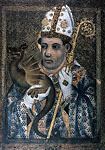Feast October 23 | Died 640 AD, Rouen, France | |
 | ||
Venerated in Eastern Orthodox ChurchRoman Catholic Church Patronage Archdiocese of Rouen, City of Rouen Similar Saint Gildard, Prætextatus, Joan of Arc, Jean‑Baptiste de La Salle | ||
Saint Romanus of Rouen (French: Romain; reconstructed Frankish: *Hruomann; died c. 640 AD) was a scribe, clerical sage, and bishop of Rouen. He would have lived under Dagobert I (629–39), though his date of birth is unknown. His life is known in legend and tradition and is shown in the stained glass windows (c. 1521) and south gate of Rouen Cathedral and the stained glass windows of the église Saint-Godard (1555). The Catholic Encyclopedia claims that his legend has little historical value with little authentic information. He was both Lord Chancellor of France and Référendaire of France.
Contents
The city's autumn "foire Saint-Romain" was set to his feast day on the "10th day of the Kalends of November" (i.e. 23 October) around 1090, at the same date as his cult was spread to the whole diocese of Rouen.
Birth and youth
His mother Félicité lamented her sterility until one night an angel appeared to Romain's father announcing that a child would be born in his house. Very young, Romanus was sent to the king's court. This was common for young aristocrats of the time - those who went were known as nourris, meaning that they effectively carried out domestic duties to the court in return for some education, before being sent back to the provinces as bishops or counts. There Romanus met saints Eligius and Audoin. When the episcopal seat of Rouen became vacant, the college of canons voted for Romanus and the king consented to their choice, offering Romain a cross.
Legendary miracles
Festival
His feast day is traditionally celebrated in the archdiocese of Rouen on 23 October, as a Triple Feast - First Class. Today they are often transferred to the following Sunday, in contravention of the date decreed for the feast by archbishop Guillaume Bonne-Ame in around 1090.
Hagiography
Four Lives of Saint Romain exist - one is a Latin verse version of the 8th century, another is a prose life addressed to the archbishop of Rouen by the doyen of Saint-Médard de Soissons. Those two lives are held in the Bibliothèque municipale de Rouen, whilst another Life is held by the Bibliothèque nationale de France in Paris.
